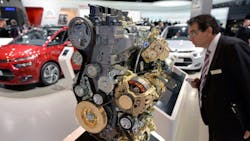FRANKFURT, Germany — Eco-friendly models and futuristic technology like automated driving look set to dazzle at the IAA auto show in Frankfurt next week, although slowing sales in China could cast a shadow over resurgent demand in Europe, analysts said.
Hundreds of thousands of visitors are expected to crowd into the massive exhibition halls of Frankfurt’s sprawling trade fair September 19-27 to catch a glimpse of the latest models and high-tech innovations.
The world’s press will get a two-day sneak preview starting Tuesday of the International Motor Show, which is held every two years, alternating with the car show in Paris.
The German carmakers’ association VDA, which is organizing the event, said the 2015 show promised 210 world premieres and an “amazing display of innovations” from 1,100 exhibitors from 39 countries, in a space the size of more than 30 football fields.
“The atmosphere promises to be excellent,” EY analyst Peter Fuss said, ‘with lots of new products and new ideas.”
In the mass-market class dominated by the Volkswagen Golf, Renault’s Megane 4 and Opel’s Astra 5 will both be vying for attention. The French carmaker will unveil a new version of its Talisman, while the German Audi will present the next generation of its A4.
But it will be the urban 4x4s, the market’s darlings, that are likely to steal consumers’ hearts, with Volkswagen and Ford presenting more affordable models such as their Tiguan and Edge, while Jaguar will show off its luxury F-Pace and Bentley its ultra-exclusive Bentayga.
For those opposed to the fuel-guzzlers, there are more ecologically-minded models — particularly interesting for drivers in Europe, which already has the most stringent transport CO2 emission goals in the world and could see them tightened at the COP21 summit in Paris in December.
Toyota has chosen Frankfurt to lift the veil on the fourth generation of its Prius flagship hybrid. BMW will also present a series combining both electric and petrol engines.
Another key focus at this year’s IAA will be exciting new technologies such as automated driving, AlixPartners auto specialist Elmar Kades said.
For the first time, more than 32,000 square feet of exhibition floor space will be given over to new forms of mobility, from the connected to the self-driving car.
Brighter Outlook in Europe
When the last IAA was held in 2013, the market had hit rock-bottom after five years of crisis, with car sales slumping from 16 million units to just 12 million. Carmakers reacted by restructuring their operations and shifting their production away from Western Europe to emerging markets.
But following these bleak years for Europe, the stage appears to be set this year for a rebound in demand, with new registrations in the region rising 8.2% in the first six months.
The European Automobile Manufacturers’ Association ACEA is penciling in growth of around 5% for the whole year. Nevertheless, “carmakers will no doubt err on the side of caution” at the IAA in view of the slowdown in emerging markets, said Ferdinand Dudenhoeffer, an auto industry expert at the University of Duisburg-Essen.
After years of double-digit expansion that turned it into the world’s biggest car market, China has seen a brutal slowdown this year, with growth projected to reach up to only 3%, or even a meagre 1.4%, according to market consultants IHS.
“Slower volume growth, added to ferocious competition, means lower margins and lower profitability,” and that poses “a big challenge, particularly for German makers which have benefitted greatly from growth on the Chinese market,” said Flavien Neuvy, auto expert at Observatoire Cetelem.
Volkswagen, which looks set to overtake Toyota as the world’s biggest carmaker this year, generates 36% of its sales in China, compared with 35% for General Motors. But foreign joint ventures in China have lost ground to wholly-owned Chinese makers, whose products are frequently cheaper.
“When you look at the rate of car ownership,” said Yann Lacroix of Euler Hermes, “there is no cause for concern about the future of the Chinese market.”
By Tangi Quemener and Estelle Peard
Copyright Agence France-Presse, 2015
About the Author
Agence France-Presse
Copyright Agence France-Presse, 2002-2025. AFP text, photos, graphics and logos shall not be reproduced, published, broadcast, rewritten for broadcast or publication or redistributed directly or indirectly in any medium. AFP shall not be held liable for any delays, inaccuracies, errors or omissions in any AFP content, or for any actions taken in consequence.
